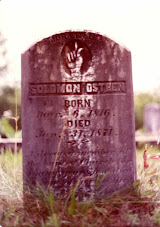 |
| Gravemarker for Claud Dunn (1906-1923) |
Gravemarkers, also called gravestones or tombstones, can reveal much more about history than many people realize. Most gravemarkers will have the name of the deceased (though sometimes there are only initials or titles like “wife”). Some may also have parents’ names, familial relationships, indicators of military service, maiden names, membership in fraternal organizations, religion, immigrant place of origin, or cause of death. Visiting a cemetery and seeing the placement of stones in relation to one another can also give clues about infant deaths not otherwise recorded, or familial relationships, such as seeing who is buried in a group and discovering a maiden name and wife’s family from nearby gravemarkers.
Gravemarker for Solomon Osteen
(1816-1871)
Another
interesting piece of information that can be gleaned from gravemarkers is
dependent on a type of symbolism that has been lost from general
awareness—gravemarker symbology. The images carved on gravemarkers had a
symbolic meaning to convey hopes for the dearly departed, pedantic meditations
on the ephemeral nature of life, and the expression of emotions about the
deceased. Some of these meanings may be apparent today, but others are less
obvious. One might guess that a lamb indicates innocence (often seen on
children’s gravemarkers) but be surprised to learn that a key indicates
knowledge and entrance into heaven.
With this
awareness, one can visit a cemetery within Transylvania County and discover much
more about the gravemarkers there than before. The Rowell Bosse North Carolina
Room at the Transylvania County Library has a photograph collection of
gravemarkers from around the county, some of which are now on display on the
second floor with special note given to the symbology of carvings. Gravemarker
rubbings are also featured, showing how this genealogical pastime can help to
preserve the imagery from deteriorating gravemarkers. A scrapbook documenting
the revitalization of the Davidson River Cemetery in 1976 gives another view of
preservation over time and how generational devotion to maintenance of
cemeteries helps to preserve these treasure troves for future generations.
Gravemarker for Julia Nathalie Forsythe, born, married, and buried on May 14.
The photo featured in this week’s Picturing the Past shows one special gravemarker that is also being highlighted in the display. Note that Julia Nathalie Forsythe was born on Monday, May 14, 1860. She married on her seventeenth birthday Monday, May 14, 1877, and was buried on Monday, May 14, 1923 at the age of 63. The dates and consistent days of the week of these significant life events are such a unique coincidence, the family chose to immortalize it in stone, leaving it for us to marvel at today.
Photographs and information for this column are provided by the Rowell Bosse North Carolina Room, Transylvania County Library. This article was written by Local History Librarian Laura Gardner. For more information, comments, or suggestions, contact NC Room staff at ncroom@transylvaniacounty.org or 828-884-1820.

No comments:
Post a Comment